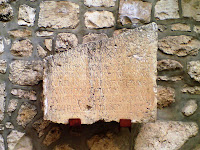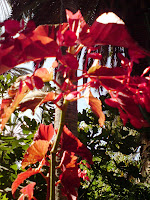The Western Wall is the most holy place accessible to the Jewish people because of Muslim control of the Temple Mount. Known in recent centuries as the Wailing Wall, this was built by Herod the Great as the retaining wall of the Temple Mount complex.
The plaza was created as an area for prayer when Israel captured the Old City in 1967. At times tens of thousands of people gather here for prayer. A dividing screen reserves an area at the extreme right of the Western Wall for women, who are not allowed into the men's section in keeping with Orthodox Jewish tradition.
At the prayer section of the Western Wall, grass grows out of the upper cracks. The lower cracks of the chalky, yellow-white blocks have been stuffed with bits of paper containing written prayers. Orthodox Jews can be seen standing at the wall, chanting and swaying. Some Jews visit the wall daily to recite the entire Book of Psalms.
Picture 1 - The foundation stone also known as "The Rock", was the heart of the Holy of Holies. According to Jewish tradition, the rock marks the center point of God's dwelling and the creation of the world. Some traditions and archaeologists locate it in the center of the Dome of the Rock which is located beyond the wall, although there are other suggested locations around the temple mount.
Pictures 2 n 3 - A model of the second temple is located on the west side of the hall, in front of a set of benches. The tour guide describes the story of the temple mount with the assistance of the model, which uses the electrical controlled mechanism to demonstrate the phases of its construction by Herod.
The arches in this artificial cavern date from various eras, ranging from Herodian (37 BC -70 AD) to Crusader (1100-1244).
The tunnel exposes a total length of 500m of the walls, revealing the methods of construction and the various activities in the vicinity of the Temple Mount. The excavations included many archaeological finds along the way, including discoveries from the Herodian period (streets, monumental masonry), sections of a reconstruction of the Western Wall dating to the Umayyad period, and various structures dating to the Ayyubid, Mamluke and Hasmonean periods constructed to support buildings in the vicinity of the Temple Mount.
Narrow streets of the Old City. We bought some freshly baked bread from a vendor along the street.
We walked through the Roman Pavement above the vault of the cistern. This pavement was made from the large courtyard stones of the Antonia which was destroyed in 70CE. Markings in the paving stones, indicating a dice game known as the King’s Game, suggested this was where JESUS was mocked by the soldiers (John 19).
The Church of Flagellation. According to tradition, this was the site where the Roman soldiers flogged JESUS after HE was sentenced to death (John 19). The church is located on the eastern side of Via Dolorosa inside the Old City of Jerusalem.
This is the view of the interior of the church, with 3 remarkable stained-glass windows : Picture 1 - illustrating Pontius Pilate washing his hands from the sin; Picture 2 - flogging JESUS and placing a crown of thorns over the head; and Picture 3 -Barrabbas rejoices on his release instead of JESUS.
Above pictures show the mosaic of the dome is designed as the crown of thorns.
Beginning in the twelfth century, Christians began to identify Abu Ghosh as Emmaus, where JESUS appeared after the Resurrection. They imagined an old caravansary they found by the village spring as the destination of the disciples as the walked along the road “about seven miles from Jerusalem” (Luke 24). Picture 3 - a confession box.
The village’s impressive Crusader church, in a tranquil garden setting, is built over that spring. Its walls are adorned with paintings of New Testament figures – some of the oldest medieval frescos in the world.
A sample of the vast variety of flowers blooming in the garden.
Picture 1 - different types of incenses - frankincense, myrth, rose of sharon, etc. Picture 2 - we also visited a shop selling all sorts of coloured stones.
Lesson from the Emmaus Road - Because of our relationship with GOD, we are assured of HIS abiding presence in our lives.
Silently now I wait for Thee,
V3









































































No comments:
Post a Comment